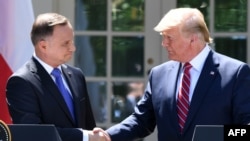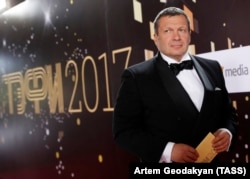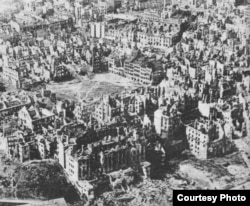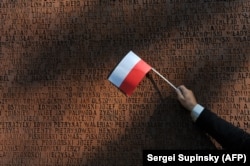During a June 12 visit to Washington DC to meet with U.S. President Donald Trump and sign a joint declaration on defense cooperation, Polish President Andrzej Duda spoke with reporters about his country’s history with Russia and the Second World War.
Expressing a desire for Poland and Russia to have friendly relations, Duda said Russia was a country that had more potential than Poland in every respect, with the possible exception of “bravery” and “courageousness.”
He went on to outline Poland’s tragic history vis-à-vis Russia, from the Soviet occupation of eastern Poland to the Katyn massacre.
Those remarks prompted comments from Russian TV host Vladimir Solovyov, who said that while understanding Duda’s “hurt feelings,” he did not understand the source of those feelings.
Solovyov said Duda could not have been offended by “Russia and the Russian soldiers, who liberated the great fighting Poles from the Nazis.”
“The Poles really fight superbly, it is well known in history, there is no reason to underestimate them. At the same time, let me remind you that no matter how valiantly the Poles fought, they could not resist the German army in 1939 ,” he added. “With all due respect to Polish prowess, I would like to note that the Russian people are the victorious people. So it was, is and will always be.”
Solovyov’s reading of history, however, is highly selective.
In referring to Poland’s liberation from the Nazis, Solovyov omits the Molotov-Ribbentrop non-aggression pact that Nazi Germany and the Soviet Union signed on August 23, 1939.
That agreement included a secret protocol that divided Central and Eastern Europe into two spheres of influence. On September 17, 1939, less than three weeks after Nazi Germany invaded Poland on September 1, the Soviet Union invaded Poland from the east.
While Russian citizens who have written about these events have faced criminal prosecution under a May 2014 law banning the dissemination of “false information about the activity of the USSR during the years of World War Two,” the Soviet invasion of Poland is an established historical fact.
During the Warsaw uprising in the summer of 1944, the Soviet Union allegedly promised the Polish underground aid to liberate the Polish capital from Nazi occupation, but then halted combat operations after initial successes by Poland’s Home Army, allowing the Germans to regroup.
Others, including American military historian David Glantz, have pointed to a major German counter-offensive against a Soviet bridgehead on the Vistula River south of Warsaw to explain the Red Army halt.
The Soviet government also refused to allow Allied forces to use Soviet air bases to airlift supplies to the Poles.
These events ultimately led to the defeat of the Warsaw uprising in October 1944, along with the destruction of the city and the deportation of its residents.
This laid the groundwork for the full Soviet occupation of Poland in the aftermath of the defeat of Nazi Germany the following year, which was further solidified by the 1946 Polish people's referendum and parliamentary elections of 1947, widely believed to have been rigged.
Thus, while the Soviet military drove Nazi forces out of Poland in 1945, Poland itself remained under Soviet military occupation until 1956, when a dedicated treaty fully regulating the Soviet military presence in Poland was signed.
Polygraph.info therefore finds Solovyov’s statement’s on Poland’s liberation from Nazi Germany to be misleading.










